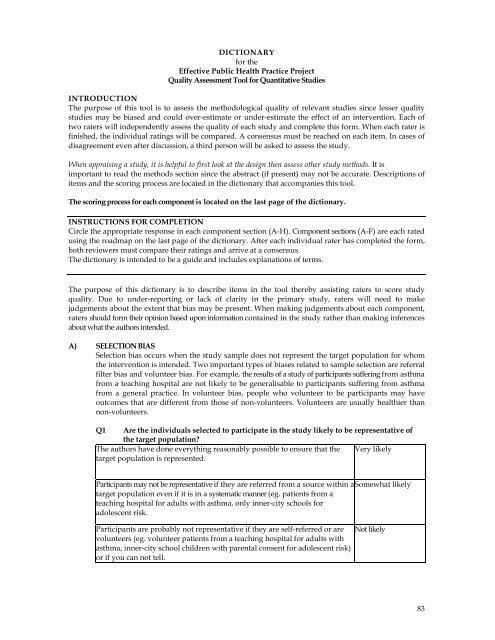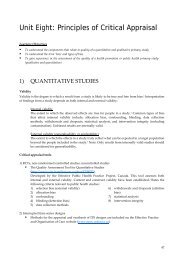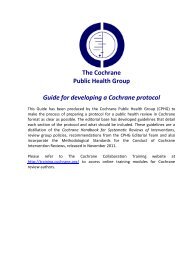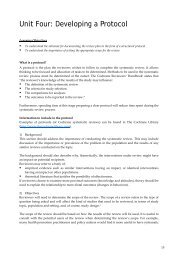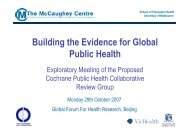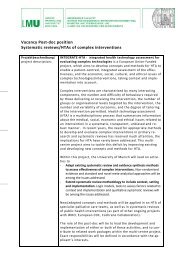Train the Trainer Course book - Cochrane Public Health Group
Train the Trainer Course book - Cochrane Public Health Group
Train the Trainer Course book - Cochrane Public Health Group
Create successful ePaper yourself
Turn your PDF publications into a flip-book with our unique Google optimized e-Paper software.
DICTIONARY<br />
for <strong>the</strong><br />
Effective <strong>Public</strong> <strong>Health</strong> Practice Project<br />
Quality Assessment Tool for Quantitative Studies<br />
INTRODUCTION<br />
The purpose of this tool is to assess <strong>the</strong> methodological quality of relevant studies since lesser quality<br />
studies may be biased and could over-estimate or under-estimate <strong>the</strong> effect of an intervention. Each of<br />
two raters will independently assess <strong>the</strong> quality of each study and complete this form. When each rater is<br />
finished, <strong>the</strong> individual ratings will be compared. A consensus must be reached on each item. In cases of<br />
disagreement even after discussion, a third person will be asked to assess <strong>the</strong> study.<br />
When appraising a study, it is helpful to first look at <strong>the</strong> design <strong>the</strong>n assess o<strong>the</strong>r study methods. It is<br />
important to read <strong>the</strong> methods section since <strong>the</strong> abstract (if present) may not be accurate. Descriptions of<br />
items and <strong>the</strong> scoring process are located in <strong>the</strong> dictionary that accompanies this tool.<br />
The scoring process for each component is located on <strong>the</strong> last page of <strong>the</strong> dictionary.<br />
INSTRUCTIONS FOR COMPLETION<br />
Circle <strong>the</strong> appropriate response in each component section (A-H). Component sections (A-F) are each rated<br />
using <strong>the</strong> roadmap on <strong>the</strong> last page of <strong>the</strong> dictionary. After each individual rater has completed <strong>the</strong> form,<br />
both reviewers must compare <strong>the</strong>ir ratings and arrive at a consensus.<br />
The dictionary is intended to be a guide and includes explanations of terms.<br />
The purpose of this dictionary is to describe items in <strong>the</strong> tool <strong>the</strong>reby assisting raters to score study<br />
quality. Due to under-reporting or lack of clarity in <strong>the</strong> primary study, raters will need to make<br />
judgements about <strong>the</strong> extent that bias may be present. When making judgements about each component,<br />
raters should form <strong>the</strong>ir opinion based upon information contained in <strong>the</strong> study ra<strong>the</strong>r than making inferences<br />
about what <strong>the</strong> authors intended.<br />
A) SELECTION BIAS<br />
Selection bias occurs when <strong>the</strong> study sample does not represent <strong>the</strong> target population for whom<br />
<strong>the</strong> intervention is intended. Two important types of biases related to sample selection are referral<br />
filter bias and volunteer bias. For example, <strong>the</strong> results of a study of participants suffering from asthma<br />
from a teaching hospital are not likely to be generalisable to participants suffering from asthma<br />
from a general practice. In volunteer bias, people who volunteer to be participants may have<br />
outcomes that are different from those of non-volunteers. Volunteers are usually healthier than<br />
non-volunteers.<br />
Q1 Are <strong>the</strong> individuals selected to participate in <strong>the</strong> study likely to be representative of<br />
<strong>the</strong> target population?<br />
The authors have done everything reasonably possible to ensure that <strong>the</strong> Very likely<br />
target population is represented.<br />
Participants may not be representative if <strong>the</strong>y are referred from a source within a Somewhat likely<br />
target population even if it is in a systematic manner (eg. patients from a<br />
teaching hospital for adults with asthma, only inner-city schools for<br />
adolescent risk.<br />
Participants are probably not representative if <strong>the</strong>y are self-referred or are<br />
volunteers (eg. volunteer patients from a teaching hospital for adults with<br />
asthma, inner-city school children with parental consent for adolescent risk)<br />
or if you can not tell.<br />
Not likely<br />
83


